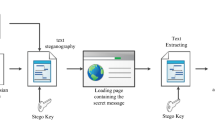Abstract
Apart from an effective steganography scheme, it is vital to have an abundance of cover medium while considering the practicability of a stego-system. Aside from images, document files are one of the most exchanged attached content via electronic mailings. In this paper, we present a structural steganographic scheme based on unseen tag attribute values using office documents as the medium. Specifically, we use the XML file that builds the core of the file documents to vehiculate the message. The secret is not visible within the text content, and the stego file size is not far from the cover size. We are among the first to investigate the unseen tag identifier within the cover document to hide the secret message. We assess the performance of the proposed scheme in terms of the invisibility, embedding capacity, robustness, and security. The performance results show the advantage of a higher capacity embedding and a better flexibility while keeping high practicability in terms of accessibility and implementation.
Access this chapter
Tax calculation will be finalised at checkout
Purchases are for personal use only
Similar content being viewed by others
References
Rabevohitra, F.H., Li, Y.: Text cover steganography using font color of the invisible characters and optimized primary color-intensities. In: 2019 IEEE 19th International Conference on Communication Technology. IEEE Press, New York (2019)
Bender, W., Gruhl, D., Morimoto, N., Lu, A.: Techniques for data hiding. IBM Syst. J. 35, 313–336 (1996)
Mei, Q., Wong, E.K., Memon, N.D.: Data hiding in binary text documents. In: Proceedings of SPIE 4314, Security and Watermarking of Multimedia Contents III (2001)
Artz, D.: Digital steganography: hiding data within data. IEEE Internet Comput. 5, 75–80 (2001)
Khairullah, M.: A novel text steganography system using font color of the invisible characters in Microsoft word documents. In: 2009 2D International Conference on Computer and Electrical Engineering, Dubai, United Arab Emirates, p. 484 (2009)
Por, L., Wong, K., Chee, K.O.: UniSpaCh: a text-based data hiding method using Unicode space characters. J. Syst. Soft. 85, 1075–1082 (2012)
Taburet, T., Bas P., Sawaya, W., Fridrich J.: A natural steganography embedding scheme dedicated to color sensors in the JPEG domain. In: Electronic Imaging 2019, Burlingame, United States (2019)
Taburet, T., Bas P., Fridrich J., Sawaya, W.: Computing dependencies between DCT coefficients for natural steganography in JPEG domain. In: Proceedings of ACM Workshop Information Hiding and Multimedia Security Workshop, pp. 57–62. ACM, New York (2019)
Bhaya, W., Rahma, A.M., AL-Nasrawi, D.: Text steganography based on font type in MS-word documents. J. Comput. Sci. 9, 898–904 (2013)
Chang, C.-Y., Clark, S.: Practical linguistic steganography using contextual synonym substitution and a novel vertex coding method. Comput. Linguist. 40, 403–448 (2014)
Mahato, S., Khan, D.A., Yadav, D.K.: A modified approach to data hiding in Microsoft Word documents by change-tracking technique. J. King Saud Univ. Comp. Info. Sci. 32, 216–224 (2020)
Khadim, U., Khan, A., Ahmad, B., Khan, A.: Information hiding in text to improve performance for word document. Int. J. New Technol. Res. 3, 50–55 (2015)
Shi, S., Qi, Y., Huang, Y.: An approach to text steganography based on search in Internet. In: 2016 International Computer Symposium, Chiayi, Taiwan, pp. 15–17 (2016)
Morkel, T., Eloff, J.H.P.: An overview of image steganography. In: Annual Information Security South Africa Conference, pp. 1–11 (2005)
Ahvanooey, T., Li, Q., Hou, J., Rajput, A.R., Chen, Y.: Modern text hiding, text steganalysis, and applications: a comparative analysis. Entropy 21, 1–29 (2019)
Agarwal, M.: Text steganographic approaches: a comparison. Int. J. Net. Sec. Apps. 5 (2013)
Kingslin, S., Kavitha, N.: Evaluative approach towards text steganographic techniques. Indian J. Sci. Tech. 8, 1–8 (2015)
Banerjee, I., Souvik B., Gautam, S.: Novel text steganography through special code generation. In: International Conference on Systemics, Cybernetics and Informatics, pp. 298–303 (2011)
Acknowledgement
This work was supported in part by the National Natural Science Foundation of China under Grant 62072061.
Author information
Authors and Affiliations
Corresponding author
Editor information
Editors and Affiliations
Rights and permissions
Copyright information
© 2020 Springer Nature Switzerland AG
About this paper
Cite this paper
Rabevohitra, F.H., Li, Y. (2020). Structural Text Steganography Using Unseen Tag Attribute Values. In: Yang, H., Pasupa, K., Leung, A.CS., Kwok, J.T., Chan, J.H., King, I. (eds) Neural Information Processing. ICONIP 2020. Communications in Computer and Information Science, vol 1332. Springer, Cham. https://doi.org/10.1007/978-3-030-63820-7_15
Download citation
DOI: https://doi.org/10.1007/978-3-030-63820-7_15
Published:
Publisher Name: Springer, Cham
Print ISBN: 978-3-030-63819-1
Online ISBN: 978-3-030-63820-7
eBook Packages: Computer ScienceComputer Science (R0)




